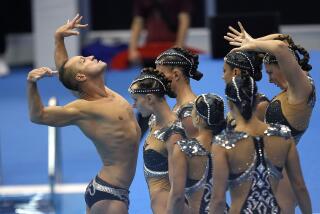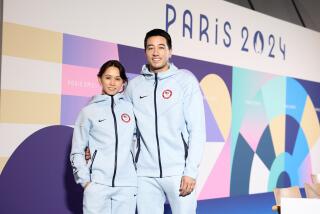Divers Seeing Double : Synchronized Sport Must Overcome Image
In sports, being in sync is good.
Being synchronized, that’s not so good.
The word summons images of waterproof makeup and costumes and odd underwater maneuvers. Synchronized swimming has ruined it for synchronized anything else.
That’s the PR problem faced by synchronized diving, a new event at most national and international diving competitions (with the notable exclusion of the Olympics).
“It’s totally different. It doesn’t have anything to do with synchronized swimming,” protests Janae Lautenschlager, 24, who trains at Mission Viejo and teamed with the Nadadores’ Amy Sloan, 18, to win the first national title in three-meter synchronized diving in April. “In synchronized diving, you’re doing the same dives you always do, you’re just doing them at the same time as someone else.”
Besides, Sloan teases, “They hold their breath a lot longer than we do.”
If it had been dubbed doubles diving, pairs diving, team diving or any one of the 50 alternatives that were suggested, synchronized diving wouldn’t face an uphill battle before people even see the eye-stopping sight of two divers arcing and tumbling in perfect silhouette.
“I tell people ‘synchro,’ and they ask me whether I’m going to wear a glittery cap,” former world champion Kent Ferguson told the Ft. Lauderdale Sun-Sentinel before the FINA/Alamo Diving Grand Prix in May.
“It’s tandem diving without the hair goo, I tell people,” Dario DeFazio of Venezuela said.
Tom Gompf, a former president of U.S. Diving, has championed synchronized diving for years and his efforts as chairman of the diving committee for FINA, the international governing body, led to the approval of synchronized diving as a medal event.
“We’ve been fooling around with it forever, as long as there’s been diving,” Gompf said. He noted there was a pairs exhibition at the 1936 Olympic trials, and that Harold Smith, the Olympic gold medalist in 1932, and Farid Simaika, the silver medalist in 1928, became well known for their exhibitions. Gompf’s goals are to expand the number of official diving events and attract spectators and television coverage in the post-Louganis era.
“It’s something everybody can follow,” Gompf said. “You can watch a good dive and not know why the judge gave it 7s or 10s. But two together, anybody can understand it.
“We want to promote the sport to anybody we can. We’re trying to get more events into the world championships. We haven’t had great success with the one-meter. It’s not spectacular enough, not daring enough. TV isn’t interested.”
Gompf was able to get synchro diving approved for competition, but he wasn’t successful at pushing through a name he liked. He foresaw the pitfalls of being called synchronized.
“Quite frankly, a lot of the divers would rather it be called something else. They don’t want to be confused with synchronized swimming,” he said. “Pairs diving or dual diving, maybe. But synchronized translates best to other languages. The international crowd says this makes sense to call it synchronized.
“Other countries don’t have the negative connotations like we do about synchronized swimming. There is even synchronized trampoline world championships, though that’s not big here. I think I may try again to change the name.”
By any name, the new event has found a stronghold in Mission Viejo, where Lautenschlager and Sloan train, as does Brian Earley, 23, who teamed with Kevin McMahon of Fremont, Neb., to win the three-meter synchro title at the Phillips 66 National Indoor championships in April, the same title the women won. Earley also competes in platform synchro diving, which can be spectacular.
“It’s quite sensational from 10 meters,” said Gompf, who saw Kongzheng Li and Mark Ruiz, 16, hit backward 3 1/2 somersaults from the tower earlier this summer. “It’s the most difficult dive in the world, and they both ripped it.”
The Mission Viejo divers’ success hasn’t been achieved by spending hour upon hour practicing in pairs. In fact, they hardly practice at all. All of them focus on their individual careers.
“Nothing they need to do is different from individual diving,” said Hongping Li, the Nadadores’ diving coach. “They just have to do it with two people, with the same timing, taking off at the same time and landing in the water and the same time.
“Amy and Janae only decided to do that a month or two months before the competition, so they practiced less than several weeks. That tells you how little practice it takes. They train four hours a day, six days a week. But I’d say an hour a week on synchro would be pretty much the maximum.”
Lautenschlager and Sloan have similar diving styles--”more graceful than powerful,” Sloan said. The also have similar looks, except that Lautenschlager is a couple of inches taller and her hair is pulled back in a ponytail instead of cut short like Sloan’s.
They are in different places in their careers. Lautenschlager, originally from Northridge, has returned to diving after taking two years to finish her degree at UCLA and begin working as an oncology nurse at Hoag Hospital in Newport Beach. Though she competed for three years at Arizona State before transferring, she found she missed diving after she began working. Now she has cut back to part-time nursing--two 12-hour shifts a week--and spends the rest of her days diving.
Sloan, a recent El Toro High graduate, will be a freshman diver at UCLA, and though the divers won’t train together as much, they’ll remain a pair.
“We won’t see each other every day but we’ll see each other at big events,” Lautenschlager said. “I don’t think it will be hard to recover our timing.”
They’ve formed a team in what remains an individual sport, regardless of nomenclature.
“Some people are too into their own diving to take time to work on this,” Lautenschlager said, and Sloan notes that “a lot of the ’96 [Olympic] contenders don’t mess around that much.”
Though many of the most elite divers don’t bother with synchro, there is plenty in it for those who do. Lautenschlager and Sloan have been the top American pair in all three competitions this year. If they win the Phillips 66 National Outdoor championship next month in Bartlesville, Okla., they’ll earn a trip to the World Cup in September in Atlanta for the biggest meet of the year. And perhaps, eventually synchro might become an Olympic event.
More to Read
Go beyond the scoreboard
Get the latest on L.A.'s teams in the daily Sports Report newsletter.
You may occasionally receive promotional content from the Los Angeles Times.






